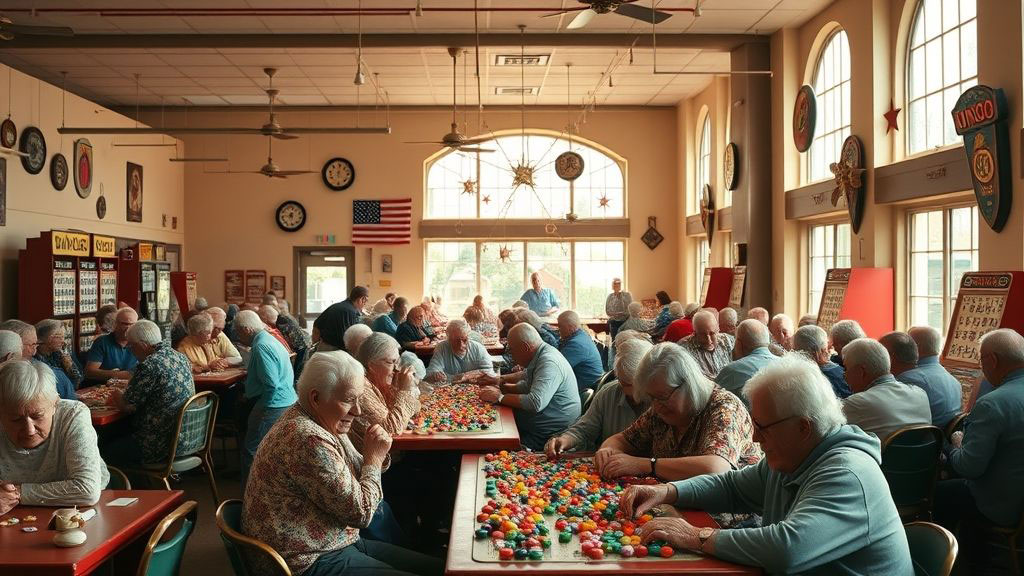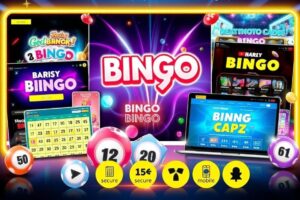In 2005, online bingo was not much more than finding its way. The big brands soon woke up to the fact their fans would like a bingo room. The concept was simple but savvy. A themed space that shouted the brand’s logo and identity was new. It was different from the no-frills generic kind of rooms at that time.
The first few branded rooms were purely average. But it was the colours, the badges and the mascots that attracted players nonetheless. Just the novelty of it had people chattering in forums and chatrooms. Fans would say, ‘Did you go watch the new [brand] bingo room? It’s got all the flair.” There was no hard sell. Instead, fans related to the label that they already admired. The jump felt natural.
Brands Meet Bingo
By 2008, the branded room was the norm. It was the year in which bingo sites’ minds got together with big brands, from pop stars to gaming companies. These rooms reflected the whimsical tone of the brand. Think of a rock band motif — tattoos, jagged fonts, raunchy banter in the chat. Or a game franchise theme – pixel art, special sound effects, level‑up vibes when you nail a line.
But these flourishes were more than mere flattery. They encouraged loyalty. A brand fan would hang out there in that new bingo room. The chat would explode with theme jokes. When guests played along, they would get scored gamified badges or unlock mini‑quests. And that felt personal. It wasn’t just bingo. Bingo under a fan’s favourite flag, it was.
Chat’s Rise and Identity
Chat in bingo became more substantial, around 2010. In branded rooms, moderators would chat in brand‑style slang. That made users feel like insiders. It wasn’t just “Hello everyone!” but “Hey mates, who’s up for rocking this round With [Brand]?” Chat wasn’t a side thing. It was the heart.
More than this, there was also a bigger push of this chat tone. Brands brought on chat hosts who could riff like radio presenters or emcees. They’d run rapid joke breaks, sprinkle in trivia about the brands, even introduce pop‑up mini‑games live. That injected life. It made everyone feel like part of a show, rather than merely a draw.
Visual Refreshes and Themed Events
By the mid‑2010s, brands realized that visuals packed a punch. Themed events around holidays or product drops began to spring up. A film release? There would be a bingo room festooned with posters, film clips, trivia calls. A video game launch? The audience can expect videos of pixel animations and game soundtrack samples.
These rooms weren’t static. Layouts changed weekly. To fans, it felt as though entering a new pop‑up shop. It preyed on FOMO, or the fear of missing out. Bingo players could not afford to miss the next themed party. And brands loved the buzz.
Loyalty Bonuses and Brand Kits
Websites started adding loyalty perks to branded rooms around 2015. Spent enough time playing games in a Rock Band room? You unlocked special emoticons or badges in the shape of guitars. Stick to a movie‑brand room and you earned a digital poster or a coupon for the film’s merchandise.
“Brand Kits” was a clever concept. Not only rewarded chat time, but made fans feel that they were in a club together. These kits made bingo about brand loyalty. Rather than prizes, they provided digital tokens of fandom.
Mobile Picks Up Speed
For a while, branded rooms looked best on desktop. Mobile was simple and small. But the mobile surge began by 2017. Brands strove to replicate those same visuals and chit chat high‑energy on phones. It was no small task: resizing mascots, rejiggering chat layouts, throwing on themed buttons.
Yet players loved it. They might play branded bingo while waiting for a bus or at lunch. This widened reach. A die-hard fan might log on at lunchtime and be treated to brand content. Bingo was safe from the home computer. It lived in pockets.
Live Shows and Voice Hosts
Speaking about something really aggressive around 2019: live audio‑hosted branded bingo. At the same time, listen to your favorite brand’s voice talent read out the numbers, tell a joke, sprinkle some trivia. It was like a radio show with bingo thrown in.
Brands would invite celebrities. A movie brand could have one of its actors deliver calls for a special night. Gaming brands invited developers. The voice‑hosted rooms provided a new twist. Bingo went beyond visual flair. Fans may have heard a tone and style from podcasts or radio. It turned branded rooms into quasi-joint ventures between the site and the brand.
Community-built Bits
2020‑2021 brought something even cooler. Brands opened up to allow fans to propose bingo card themes, chat shoutlines, even prize concepts. A music‑brand room might even ask fans to offer up favourite lyrics for bingo calls. Or a sports brand could request match memes to dunk in chat.
These weeks of community programming did two things. One, they gave players the sense that they were shaping the room. Two, they built buzz for the next event. A tweet or Instagram post along the lines of “Your lyric could be the next bingo call!” convinced fans to join. Cross‑promotion on social media helped it spread quickly.
AR and 3D Bingo Rooms
Augmented reality found its way in by 2022, the idea being that in branded rooms, you would be able to point your phone camera at parts of the room: masks, or themed props could be placed instead onto a real‑world space. Need a comic book hero mascot frantically hovering to your side while you mark your card? Sure. Spot a circulating mini spaceship as you hit a number? Yep.
The 3-D virtual rooms were also given more detail. Suddenly, a brand’s “theme” could come with room textures, ambient sounds, small animations. No longer just flat designs. This tech fostered a deeper sense of fandom. Fans got to feel like they’d wandered into a parallel universe constructed by their brand of choice.
Cross‑Promotion and IRL Perks
By mid 2023, marketing teams had set their sights way past the screen. Several of the branded bingo rooms began to offer real life prizes. Spend a certain number of hours at the room and get a discount code for the brand’s shop. Or smash in‑room targets to reveal exclusive backstage content, demo keys or access to the IRL events themselves.
Again, this boosted retention. Bingo players stayed longer. They felt a purpose. But it was also not only about earning digital badges. It had real‑world linkbacks. Brands embraced this synergy: The bingo room served as an entry point to their larger universe.
AI‑Powered Personalisation
Fast forward to 2024 with brands doubling down on AI. Not generative prose—but helper tools. These allowed bingo rooms to customize their content. The system would propose slight modifications based on user history: a room specific to a film brand that greets you with the latest teaser, say, or provides you with a themed avatar. The chat host might get the sense that you enjoyed a prize type if you won it once, so they would offer similar prizes.
Again, this was not AI-best-greatest hits. Just quiet tweaks. But it also made bingo rooms feel less generic, and more personal. Each brand room was a mirror image of your profile.
Regulations and Ethical Moves
With growth came scrutiny. Regulators began scrutinizing the overlap between bingo and brand marketing. So in 2024 – 2025, brand rooms got a more explicit disclosure. Prizes that were sponsored would be declared by chat hosts. Bonus terms were made plainer. Surprise features got explained in‑room.
This made fans feel safer. They trusted the rooms more. And the brands could wear transparency as a badge of honor. It was smart PR.
The 20‑Year Rewrite
Here et voilà, here we are in mid-2025, looking back at a long curve. A branded bingo room was a novelty in 2005. By 2025, it is a slick marketing channel. One that blends visuals, audio, mobile tech, voice branding, community‑co‑creation, AR and real‑life perks. The lowly web‑based bingo room found itself transformed into a cross‑media art form.
Brands today are built around three pillars: identity, reward and immersion. They desire rooms that match their timbre. That shopping or Netflix tie-in ticks downward. That pull in fans and chat communities. All while remaining comfy and fair.
Lessons Learned
What have been the lessons for developers and brands along the way? First, small touches matter. A badge in chat offers fans a cheer. Second, phone is king. If there isn’t a branded room that is mobile‑proof, it’s not going to grow. Third, players are hungry for voice and personality. A bland voice host flaps; a racy one can make the room pop. Fourth, tech is only effective when it is seamless. A smallish AR cameo is fine; a full app‑scale push requires clear ROI. Fifth, transparency builds trust. Transparency on prize links or marketing erases any ambiguity for host and crowd.
What’s Next?
What might the years to come hold? Imagine VR‑style rooms, perhaps even full‑on virtual theatres. I imagine branded bingo shows with hologram people walking around in your living room. Now think about the cast of a movie hosting a live game of bingo in VR. The fandom potential is huge. We might even be treated to cross‑brand mash‑ups. A film meets sports room. Customers from both sides. Co-branded calls such as “Score a corner kick and win both badges!”
AI driven by voice could take over for chat hosts altogether. But I suspect the brands will keep live hosts; they lend human flair. Voice‑AI could perform in a pinch, but fans savor a live voice who can riff off what people are posting in the chat window.
Final Thoughts
Branded bingo rooms have really come a long way. From simple themed skins to live voice shows, AR cameos and real‑life bonuses. They were no longer novelties but staples of the marketing world.
What stays true is connection. Brands that treat this “room” like another ad lose fast. The ones that add tone or club feel or even perceived value stick. Mystery film room or guitar rock room — fans will feel the connection, and the room will hum more.
It’s the human touch, in short, that brands crave. Tech, visuals, jargons ebb and flow. But that spark in chat, the host’s voice, the shared jokes — that is what brings players back. And 20 years later, branded bingo rooms continue to hit their mark when they feel more fan than flashing ad.
A Toast to Two Decades
Here’s to twenty years of branded bingo rooms. From early themed skins to today’s multi‑media hubs. A nod to every host, fan‑designer, mod and brand manager who helped push them forward. I’m excited to see where the next twenty take us.








